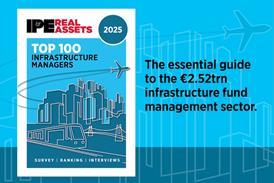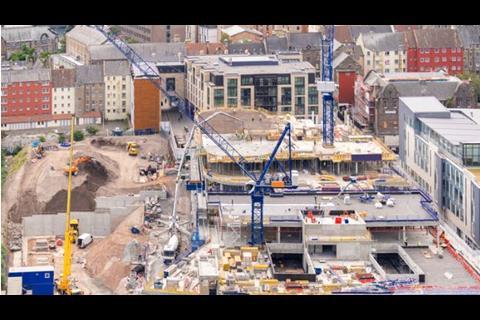Construction costs have been soaring, putting investors, developers, and contractors under pressure. Here, international real estate consultant, Hollis, outlines the inflationary issues from first-hand experience…and some tactics to mitigate them.
These are not normal times. Developers and construction firms are facing unprecedented costs increases for projects. So much so that the financial viability of some schemes is being tested, according to international consultant, Hollis.
But while the company says there is no “silver bullet” to neutralise the phenomenon, some tactics can be deployed leading to better outcomes.
Talking with PropertyEU, Mark Smith, Head of Cost Management at Hollis with global responsibility for the service said in H2 2021 hyperinflation saw spikes in construction material prices, with rises being unrelenting since. Forecasts for the full year 2022 range from +2.2%-4.5% depending upon the source of materials. The RICS trade body is reporting its “All In Tender Price Indices” and “Regional Tender Price Indices for London” as +6.7%.
Smith says a triple whammy has taken place. First it was Brexit following the 2016 vote to leave the EU, then supply issue calamities due to Covid-19-induced lockdowns, and thus far in 2022 energy price rises.
Just one live issue faced by clients is to do with the challenge in fixing prices for contracts. A lot of investors and contractors like fixed price contracts. Naturally, they make allowances for inflation – prices always tend to go up a little each year. But in a sign of how unnatural things have become, some contractors are coming back to say they simply cannot tender a fixed price any longer because their suppliers cannot do so in the first place.
‘There’s been a real change. I've done this job for getting on for 30 years, and I've never been in a position whereby contractors are turning around to say they cannot fix the price.’
‘I’ve never seen prices rise like this, and how frequently they are going up, and it is still going! The most recent issue of rising energy prices is leading manufacturing costs to go through the roof so we have got this kind of perfect storm.’
He continues: ‘It’s been totally unprecedented, and the issue our clients are having is pretty obvious – some projects have narrow margin. I think we are starting to see the viability of some of these schemes being tested.’
‘In some sectors like industrial, there is a huge amount of demand. The three key components you've got are concrete, steel and cladding but the rent is going up as well, so the viability still works. But I think there are some other sectors, potentially office and residential for example, where returns are going to get a knock because of the input prices. This is combined with how finance rates are going up for developers. So, it will be interesting to see how developers are going to respond to the new increases in materials and construction problems, along with potentially the increased cost of finance.’
He relates how the war in Ukraine has added uncertainty, leading to a contractor stating recently why it was increasing its tender. The same firm reported that when fixing prices in the last few weeks alone, suppliers had added around £1.4 mln (€1.62 mln) in notified or fixed price allowances on top of inflation already factored in.
The facts on price rises for materials are startling (see below). In 2021, steelwork costs jumped 30% and concrete 15%. Both are being further driven up by energy costs given the huge amounts of energy each need to produce them.
Anecdotally, Hollis’ Smith says he has just left a site where the parties are attempting to agree on additional works. But the costs of tarmacking have rocketed since it was first priced in November 2019. It has gone up by 100%! The next price increase is expected this month (September) and the next one in January 2023 and then June, and the prices keep going up.
Smith also says he just had a conversation with a contractor about the cost of Rebar, the steel bar or mesh of steel wires used in reinforced concreate and masonry. ‘The contractor thinks the cost might start to come down a bit, but I would be very surprised because energy prices are still going up.’
Without trying to depress readers too much, labour costs are rising as well. In H1 of 2021, there was a moderate increase, but since then there has been a jump of 2.2%, according to the Building Cost Information Service (BCIS).
Remember, the industry was still grappling with legacy issues from Covid. For example, during lockdowns, gypsum factories were closing. Suddenly, no plaster boards could be provided for interior walls and ceilings. Being in short supply, costs obviously went up. Explains Smith: ‘It was a similar story for a number of other products and materials because of lockdown and we have never really seen the prices come back down since then.’
Dan Ferrao, cost management lead for the Netherlands, based in Hollis’ Amsterdam office, says all the cost issues in the UK are being witnessed across Continental Europe.
Solutions
‘It is happening everywhere, and we see it across all of our offices. The resilience of the construction sector is being tested. I also think escalating costs are resulting in more contractors coming back with higher tender prices and they’re also increasing their risk, putting risk on risk, which they are passing on.’
‘We get involved in projects at various stages, and it is about doing the right things at the right time.’ He says collaboration is key.
‘There are projects already in flight – already being built - and the costs are going up, so it is about managing that. It's about collaboration and proper due diligence at an early stage. If material costs are expensive, potentially early orders can be made and the materials stored after negotiating with the contractor. For projects at an early stage, we carry out feasibility estimates and ensure enough flexibility is built in to allow for price increases.’
He says typically it is a good idea to find ways to better procure and manage material waste and inefficiencies. Especially for projects lasting more than a year, analysing material costs can be crucial, and then reacting quickly to issues that arise.
Procurement and timing of material ordering is paramount in a volatile market. Understanding your supply chain is key and sometimes, new arrangements involving bulk purchases or greater discounts can be achieved. If the origin of materials can be analysed, so too can the lead-in time and the possibility to find an alternative source.
Ferrao explains there will also be times when reviewing design specifications of a project should be carried out to assess if modifications can be made. Prefabricated elements of a building might also be an option. Also, labour and material management software can be brought in to keep a closer eye on costs, material use, and any price increases.
Smith adds: ‘One of the really key lessons for us is to stay close to the supply chain, particularly on large projects where we do a lot of market testing with subcontractors and their supply chain. We talk to them about what is coming down the line to assess what can we do to avoid some of these price increases that will ultimately help our clients secure the best price.’
‘A lot of our clients are quite risk adverse and go for fixed price tenders because they get that price certainty. But one of the big things we found over the last 8 – 10 months particularly on big projects is contractors coming back to say they simply cannot fix their price because their suppliers cannot fix their prices. Or if they did, they are adding so much risk into the price that the budget is getting blown out of the water. That is starting to lead us towards two stage tenders, but then that risk is transferred onto the client, and they are not always comfortable with that.’
A two-stage is like an “agreement to agree” on specifics later in the process.
Hollis has been working very closely with clients on a £100 mln residential refurbishment. For this, a “quasi” two stage approach has been used to agree a fixed price in the second stage following the Letter of Intent. Happily, the first part of the work involves mainly stripping out the space. The materials required for the first six months are also not too burdensome.
He says one of the contractors is holding early discussions with the supply chain. This is certainly part of the armoury of tactics that can be used to mitigate “lead ins”. Early discussions are critical.
In some cases, contactors have sought fluctuation clauses to be inserted to share risk, sometimes just for certain costs elements. For example, at one project Hollis is involved in, a fluctuation clause has been agreed to combat rising costs of diesel that gas guzzling machinery is using to shift soil.
All of the best practice steps are being taken and are increasingly important. Hollis’ Smith does not yet see an end in sight to the rapid price increases, so for the moment, owners, developers, occupiers and funders are caught in the same issue, and collaboration is key.
STAGGERING PRICE RISES FOR MATERIALS AND EQUIPMENT
In 2021, steelwork costs jumped 30%, concrete 15%. Both are being further driven up by energy costs given huge amounts of energy needed to produce them.
Hollis says imported sawn wood is up 40% with a rise of nearly 35% in Q4 2021 alone. In July 2021, chipboard and MDF rose 17%, then by another 10-25% in September last year. Drainage products rose 17%., bricks went up 13%, and lintels 30%. Bagged cement has risen 23% since January this year, while mortar went up 10% in 2021 and then another 12-15% since January.
The advisor adds that insulation costs went up 15-25% in 2021 and one supplier has just upped its costs by another 10-15%. Vinyl floors are set to go up 3-18% this year, depending on the type and supplier, and that is on top of 2021 rises.
Meanwhile, contractors say kitchens costs are increasing across their supply chain by 15-20% this year.
Sadly, there is more. Fuel costs have gone up 12%. From 1 April, contractors in the UK can no longer use tax efficient red diesel in plant and machinery, thereby adding more cost. Meanwhile, costs for mechanical and electrical systems have not escaped, up 6.7% in 2021 according to the Building Cost Information Service (BCIS).
But Hollis believes the true rises could be steeper as Brexit and the global shortage of containers have conspired to worsen things. A lot of mechanical and electrical plant/systems come from Europe where container costs have rocketed from around £2,500 pre-Brexit to over £10,000 now, and prices are still rising.
*This article is drawn from an interview with Hollis on 25 August 2022 and appears in the combined September/October 2022 edition of PropertyEU as a Content Partnership.
Supporting documents
Click link to download and view these filesHollis interview
PDF, Size 0.2 mb













